Put Your Hands Together For… Empalmes
The cuisine of the Mexican state of Nuevo Leon is… generally fairly meat-forward. Cabrito, or young goat, is a staple, a holdover from the Spanish Jews who founded Nuevo Leon’s capital city, Monterrey. Goat is used in numerous ways there, whether cooked on a stick over an open fire (cabrito al pastor) or in a tomato-based stew (cabrito en salsa), its organ meats cooked in its own blood (fritada de cabrito) or organs and tripe wrapped in intestines and grilled (machitos). Goat is far from the only meat consumed on the Neoleonés table, though–grilled arrachera, or skirt steak, is popular there; as is barbacoa, eaten in tacos; beef jerky, rehydrated in a stew called machados or simply eaten out of hand. Pork is roasted there, its skin made into chicharrones, its flesh swaddled in masa to make tamales.
Today’s sandwich, a snack commonly served in the Valle de Salinas area north of Monterrey, is not, strictly speaking, a meat dish. It consists in the main of a layer of refried beans spread between two tortillas. Is it vegetarian then? Hell, no. The beans are cooked with lard, they are spread on tortillas that have been dipped in or spread with lard, and often have chorizo mixed into them or stewed meats added atop them. The beans are essential; the tortillas are essential; the lard is essential. All else is a flourish.
I have assembled a set of recipes that I used for these empalmes. These recipes are not intended to be authoritative. As usual, I have read a number of (translated) recipes, and watched a number of (untranslated Spanish language) Youtube videos about making empalmes, and taken the pieces that made the most sense to me and Frankensteined them together into a kind of “the good bits” amalgam. For example, this man starts with a base of rehydrated chilies that he purees into a paste, much like the beginnings of a dish called Chile Colorado. Then he cooks the chili paste in lard and uses it to flavor his beans, his meat, etc.
So I began the same way, working in some of the other lessons I’d learned from my research.
Chile Colorado Base
Equipment
- 1 Molcajete
Ingredients
- 4 dried ancho chilies
- 6 dried guajillo chilies
- 1 quart chicken stock
- 1.5 cups water
- 5 cloves garlic
- 2 tsp Mexican oregano
- 1 tsp whole black peppercorns
- 1 tsp dried piquin chilies
- 2 tsp cumin seeds
- 1.5 tsp kosher salt
Instructions
- Remove seeds, stems, and ribs from dried ancho and guajillo peppers.
- Heat chicken stock and water in a pot and add dried peppers. Bring to a boil then reduce and cover. Simmer for 30 minutes.
- Dry-toast black pepper, piquin chilies, and cumin seeds in a pan for a minute or so
- Add pepper, cumin, oregano, salt, piquin chilies, and garlic to molcajete and pound to a paste.
- After the chilies have simmered for 30 minutes, remove from heat and let cool for an hour or overnight. There should be about 1 quart total volume between solids and liquids.
- Take chilies from liquid and put in blender. Add a small amount of the simmering liquid to the molcajete and use the mortar to scrape and loosen the paste from the molcajete. Pour the paste into the blender, and rinse with more simmering liquid if required. All the simmering liquid and molcajete paste should end up in the blender.
- Puree the chili mixture until smooth. Reserve for use in other recipes
Then I went ahead and made Chile Colorado with some of the base I’d prepared.
Chile Colorado (for taco filling)
Ingredients
- 2 tbsp lard
- 1 lb beef stew chunks
- 1 small-to-medium white onion diced
- 1 tsp paprika
- 1 cup Chile Colorado Base see recipe
- salt and pepper
Instructions
- In a stainless steel or cast iron pan, heat the lard over medium high heat
- Season the beef chunks with salt and pepper, then add to the pan. Brown well on all sides.
- Remove beef from the pan and add the diced onion. Move the onion around the pan, using the moisture it releases to deglaze the pan.
- If the lard has been mostly absorbed by the beef and onions and they appear dry, add more lard. Then pour in the Chile Colorado base. Finish deglazing the pan with this liquid, and allow it to cook in the lard for a few minutes.
- Return the beef to the pan and add the paprika. Cover, lower heat, and simmer until beef is tender and falling apart.
- Serve as is with tortillas, or shred for a sandwich filling
I also made my beans using the Chile Colorado base
Refried beans (for empalmes)
Ingredients
- 1 lb dried pinto beans
- 1 cup chile colorado base (see recipe)
- 1 tsp cumin
- 1 tsp Mexican oregano
- 1 onion diced finely
- 2 cloves garlic minced
- 2 tbsp lard
- 1 lime
- salt and pepper
Instructions
- Pick through dried beans and remove stones, bad beans, etc. Cover with water and allow to soak overnight (12 hours)
- Drain beans and add them to a pot. Cover again with water and boil for 1 hour.
- Drain beans and reserve some of the liquid
- Heat lard in a medium to medium-low pan. Add onion and sautee until translucent. Add garlic and cook for 30 seconds, then chile colorado base and cook for another minute or two.
- Add boiled beans, cumin, oregano. Mix together well in the pan and cook, mashing the beans as you go. If they get dry, add some of the reserved bean liquid as necessary. Cook and mash until they reach the desired consistency.
- Season with salt, pepper, and lime juice, and serve
I also made chicharrones in salsa verde to use in Empalmes
Chicharrones in salsa verde (for tacos)
Ingredients
- 6 tomatillos
- 1/2 white onion (in a single piece)
- 3 cloves garlic
- 1 handful cilantro
- 1 lime
- 1/2 lb chicharrones
- 2 tbsp lard
- salt and pepper
Instructions
- Heat a pan over high heat. Add the half-onion (unchopped), garlic cloves, and tomatillos and char well.
- Once the surfaces of the vegetables have been well-charred, remove to a blender along with the cilantro and puree.
- Heat lard in pan over medium heat. Add chicharrones and allow to sautee for a minute, then pour in the salsa from the blender. Add a small amount of water if required.
- Cook the chicharrones in the salsa until they have absorbed the salsa and softened. Season and serve.
This is an excessive number of recipes for a single blog post. I understand this. And yet I have still not broached the topic of the actual sandwich I am making. All this was prep work. In addition to the above, I also hand-shredded some Queso Oaxaca (it pulls apart nicely into strands like string cheese) and I cooked a pound of beef chorizo, which was seasoned aggressively and had a nice vinegary sourness, reminding me of a brief description of the “chorizo ranchero” used in Nuevo Leon that I read in this Empalme recipe.

And speaking of Empalme recipes, one more thing I did with the Chile Colorado base is described in my Empalme recipe:
Empalmes
Ingredients
- Corn tortillas
- 1/4 cup Chile colorado base
- 1 cup lard
- Refried beans (see recipe)
- Chile colorado (see recipe)
- Chicharrones (see recipe)
- Queso Oaxaca Shredded or pulled apart into threads
- Pan-toasted, ground piquin peppers optional, for garnish
- Salsa
Instructions
- Mix chile colorado base thoroughly into lard; set aside.

- Take two tortillas in hand. Spread one side of one of them with the lard mixture.

- Smear the lard side of that tortilla onto one side of the other tortilla and leave them stuck together. (This will allow you to handle the tortillas while topping them without covering your hands in lard)

- On one tortilla, spread beans and whatever additional fillings this Empalme will contain. (Some options: beans only, beans and shredded chile colorado, beans and chicharrones, beans and cooked chorizo, any of the above with added Oaxacan or Cotija cheese)

- Season with piquin pepper flakes or salsa, if desired.
- Carefully separate the bottom tortilla from the topped tortilla without spilling the toppings. Place lard-side out atop the fillings and cook both sides on a grill or griddle until crisp.

- Serve hot, cut into quarters.

About that salsa–most descriptions of the dish will call for an orangish salsa made with piquin chilies, cumin, oregano, garlic, and vinegar. It occurred to me that all those things were already in my Chile Colorado base. So to make the salsa, I simply thinned out that paste with some cider vinegar in a blender. It makes a terrific hot sauce, flavorful without being overwhelmingly spicy. But it did not turn out as orange as the piquin salsas I’ve seen while reading about the sandwich. I’m happy with my salsa, but here is a video describing one process for making a piquin salsa.
The Classic: Refried Beans
Empalme, at its most basic, consists of this. Tortillas of nixtamalized corn, dipped in lard–or, if you live in a cold place like I do and your lard is resolutely solid, you can do what I did and spread it on with a knife–sandwiched together and cooked on a grill, or in a griddle. The word “empalme” translates as “splice” or “joining”–the name comes from gluing those tortillas together with that layer of beans.
It is my understanding that a single-decker such as this may be the most common option but is not the end–some people stack multiple layers of beans and lard and tortillas before cooking the empalme up crisp and hot. I am working my way through several of these so I’ll keep it simple for this inaugural empalme outing.
The salsa is often put inside, to flavor the beans more directly, but I enjoyed adding a little to each bite as I went. The beans themselves have a little heat to them, having been cooked with some of the Chile Colorado base in them, and the sauce owes as much of its flavor to vinegar and garlic as it does to dried rehydrated chilies–in a very good way. My main nit to pick is that the beans soften and thin as they heat, making it difficult to get very much inside, and they do not grab onto the tortilla and hold it in place the way cheese would.
An Upgrade: Beans and Cheese
Enter: cheese. I didn’t get a clear consensus for a specific cheese that was invariably used in an empalme. Some recipes used queso fresco, some used cotija, others used a melting cheese like queso quesadilla. I happen to like Oaxacan cheese, so that’s what I used.
The cheese’s contributions went beyond merely helping to glue the tortillas together a little better. It also melted out the sides and caramelized against the griddle, creating tasty crunchy bits around the edges. If I had more space on my skillet, and more confidence in its non-stick properties, I might make one with a full cheese skirt. But it’s indisputable, at least to me, that the empalme with cheese is superior to the one without.
It’s Flavor Time: Chorizo, Beans, and Cheese
Refried beans and chorizo are natural partners. Decades ago, when Mindy and I were visiting some vegan friends in St. Louis, they served us tortilla chips and a dip made of vegan refried beans and vegan chorizo. I was a bit more callous in those days and tried the dip, fully expecting to hate it and say something unfortunate to our generous friends. It was delicious though, and I could only thank them and keep stuffing it in my mouth.
Similarly, many people when preparing empalmes will simply mix some chorizo into the beans before making the simple, bean-spread-only version above. I can’t help but think that would be delicious. But I had plans for these beans, and kept the chorizo separate this time.
This beef chorizo had big flavors, sour and salty and spicy, tamed as much by the beans and cheese as it was complemented by them. Even the spicy, sour, lingering garlic flavor of the hot sauce barely made a dent in the chorizo. If you like big flavors, this is the way to go.
Bringing the Heat: Chile Colorado, Beans, and Cheese
If you laugh in the face of danger and skip right past anything with less than 3 cartoon chili peppers next to its name on a Thai restaurant menu, this warning is not for you. For the rest of us: chile colorado packs some heat. This beef was stewed in, essentially, a paste made from chicken stock and rehydrated chili peppers, and it’s beefy and spicy and garlicky and spicy again, similar to a Texas-style beanless chili if it were cooked until the meat fell apart into shreds. There’s no state-based confusion here–“Colorado” here does not mean the state but is Spanish for “red-colored” and refers to the bright hue of this Mexican stew.
We like big flavors though, especially when they’re going to be mixed in with beans and cheese and tortillas, and the resulting empalmes are spicy but quite bearably so, even to the less spicy tolerant. At least, they were preferred over my own personal favorite filling:
A Matter of Taste: Chicharrones in Salsa Verde, Beans, and Cheese
It’s not for everybody, I guess. I like them plain, fresh and crisp, fatty and a little salty, right out of the package from the Mexican market. I like them in big sloppy burritos, when I’ve maybe had a few drinks and need one good decision to forestall any further bad ones. I like them on huaraches, I like them in quesadillas, I like them in tacos. I am just a fan of chicharrones. They are especially good when they’ve been cooked down a bit in the salsa, enough to have absorbed much of the liquid but they haven’t fully given up their crisp texture yet. That timing is a balancing act though. I’ll take them, as Gollum liked his fish, wet and wriggling.
My salsa verde recipe above for these chicharrones does not contain any chilies, and that was deliberate. I wanted to provide at least one non-spicy option, even though the beans themselves had a good level of heat. And truth be told I was hoping that a chicharrone-averse member of my household might be enticed into trying them. That did not happen. The good news is, there’s a good amount of chicharrones left over, and they’re all for me.
I liked these empalmes. Given the amount of lard that went into cooking both the sandwiches and most of their ingredients, they were a bit on the greasy side. Next time, I might cook them over a grill, so that the fat could drain away. I would make them again though! There are never too many different ways to combine tortillas deliciously with spicy foods!

I like sandwiches.
I like a lot of other things too but sandwiches are pretty great


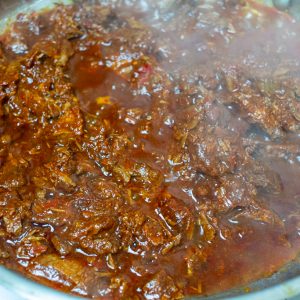
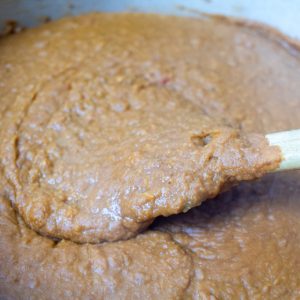
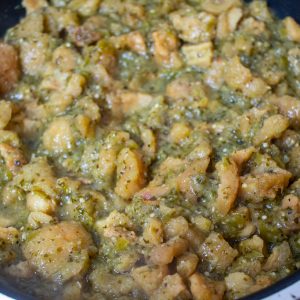
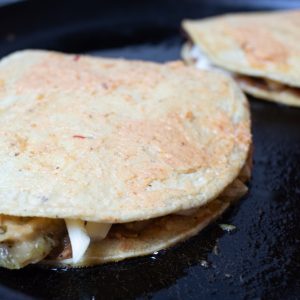
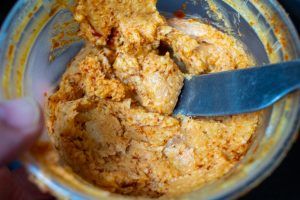
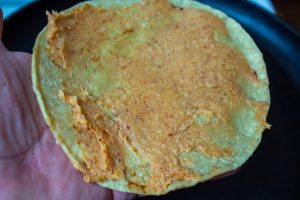
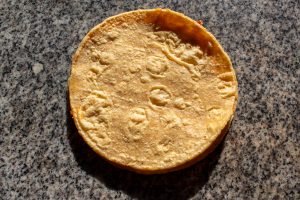
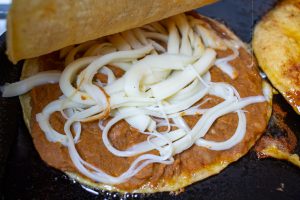
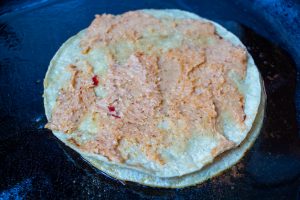

































Recent Comments